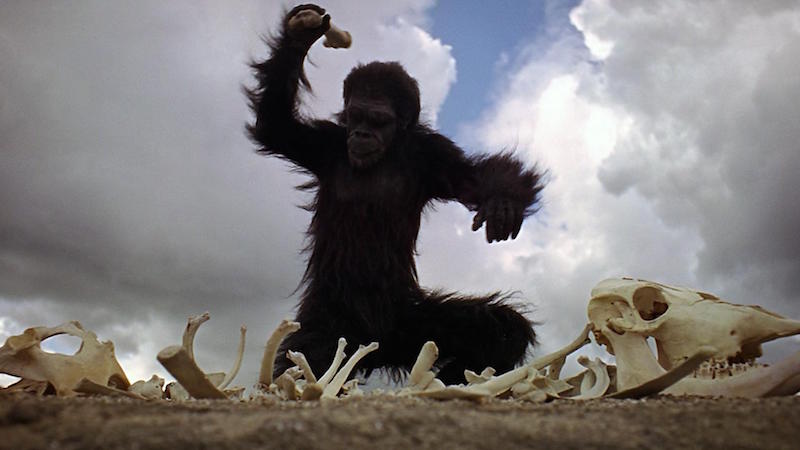The Clements Blog
Music and the moving image: a marriage of equals?
by Jamie Welton
Wednesday, 21st October 2015 |
Music and the moving image are seemingly linked at an almost genetic level. But is it a one-sided relationship? Does the use of classical music and opera in films and TV enhance the medium or is it merely a cynical ploy to add quality to otherwise low standard productions?

Of course, the answer is never a simple 'yes' or 'no', but a more
realistic 'sometimes'. As in any relationship, when the chemistry works, it's
spectacular, but a limp film can rarely be coaxed back into life with a great
score.
The film production machine latched upon classical music from the first
flickerings of cinema and the relationship has latterly become more symbiotic
as the familiar strains of a classical score such as Richard Strauss' Also sprach Zarathustrabecomes
inextricably linked to the film in which it appears – Stanley Kubrick's 2001:
A Space Odyssey (1968) (remember the ancestral apes discovering 'tools' to
the dramatic dum-dum, dum-dum, dum-dum of the timpanis). Conversely, the film
catapulted Strauss' score into the public domain – though most people will know
it as the 'space' music from that odd film about apes bashing bones, rather
than the composer's interpretation ofFriedrich Nietzsche's philosophical novel.
Music
and image in harmony
Some films are blessed with a sublime script,
unforgettable direction and talented actors working at their peak. Add a score
which accentuates the dramatic, amplifies emotion and enhances the spectacle
and you have created a 'classic'.
As Trevor Howard's virtuous doctor becomes smitten with Celia Johnson's
bored housewife in Brief Encounter
(1945, director David Lean), the doomed relationship is played out to the
strains of Rachmaninov's Piano
Concerto No. 2, heightening the tension in their weekly railway station
liaison and ensuring the final parting of the 'lovers' is burned into cinematic
history.
Spool forward 34 years and Francis Ford Coppola effectively reinvents Richard Wagner's Ritt der Walküren (The Ride of the Valkyrie) for a new generation in Apocalypse Now (1979). No longer does
the score accompany the Valkyrie sisters on their hunt for lost heroes, it now
signals the impending violence set to be unleashed on a Vietnamese village by
Black Hawk helicopter gunships. Again, film takes music and gives it a second
life.
In
John Boorman's Arthurian epic Excalibur
(1981), the dramatic chords of Carl Orff's O Fortuna, from Carmina Burana, herald the Lady of the Lake as her hand breaks the
surface of the water to hold forth the legendary sword. Such is the power of
the association with moving pictures, Orff's score has become the standard for
dramatic entrances.
Though
widely panned by critics, James Bond's 22nd outing, Quantum of Solace (2008), contains all
the ingredients fans expect – fast cars, faster women and bone-crunching fight
scenes. However, director Marc Forster takes the opportunity to choreograph an
otherwise routine fight sequence at the opera in Bregenz, Austria, transforming
it into an almost balletic passage devoid of sound effects, instead overlaying
the scene with Giacomo Puccini's menacing score from Tosca.
Subverting the form
The outwardly perfect marriage of music and screen falls down in the
corporate world of advertising. The rough treatment and dumbing down of opera
for commercial use and the cynical use of classical music to motivate the
populous to spend is merely subverting the form.
Caricatured opera singers warbling thinly disguised sales messages and
misplaced classical favourites masquerading as branded aural billboards do
nothing to popularise or entertain. However, in the 70s, 80s and 90s, some TV
adverts became as known for their classical soundtrack as for the product they
are attempting to flog. The Hovis ad featuring a brass band version of Largo
from Dvořák's
Symphony No.
9 (the
New World Symphony), Bach's Air on the G String from the Hamlet cigar
adverts, and another use of Orff's O Fortuna in the Old Spice 'surfing' ad were all
classics of the era.
For
a younger audience, the visually striking ad for HP's TouchSmart PC featured
paper 'fireworks' accompanied by Summer from Vivaldi's Four Seasons,
while credit card firm American Express used the
Prelude from Bach's Cello Suite No. 1 (in G major, BWV
1007) to highlight
the sad and smiling faces seen in everyday objects. Tech heavyweight Microsoft
embraced the classical genre for the launch of the Windows Phone 7, setting its
ad to a sampled version of In the Hall of the Mountain King from Peer
Gynt by Grieg.
Returning
to the original question – is the relationship between music and the moving
image one-sided? The answer has to be 'no', but only when the music lifts the
moving image to greater heights than the visual image can perform alone.
Looking
at the relationship another way, the moving image has given classical music and
opera a new lease of life, introducing it to new audiences, who may never have
attended, or thought of attending a classical concert or opera performance. As
with all the most successful relationships, parity of power makes for the most
harmonious partnerships.
Tags
- composers (6)
- instruments (3)
- Avant-Garde (2)
- science (2)
- opera (2)
- singing (2)
- words (2)
- orchestras (2)
- joke (2)
- discovery (2)
- Schidlof (1)
- Kates (1)
- Menuhin (1)
- Bertolotti da Salo (1)
- Xin Lu (1)
- Gagliano (1)
- Stradivari (1)
- musical instruments (1)
- Auction (1)
- advertising (1)
- TV (1)
- film (1)
- Classical music (1)
- musicians (1)
- auditorium (1)
- concert (1)
- Acoustics (1)
- conductors (1)
- weird (1)
- quiz (1)
- ideas (1)
- comedy (1)
- cinema (1)
- wedding (1)